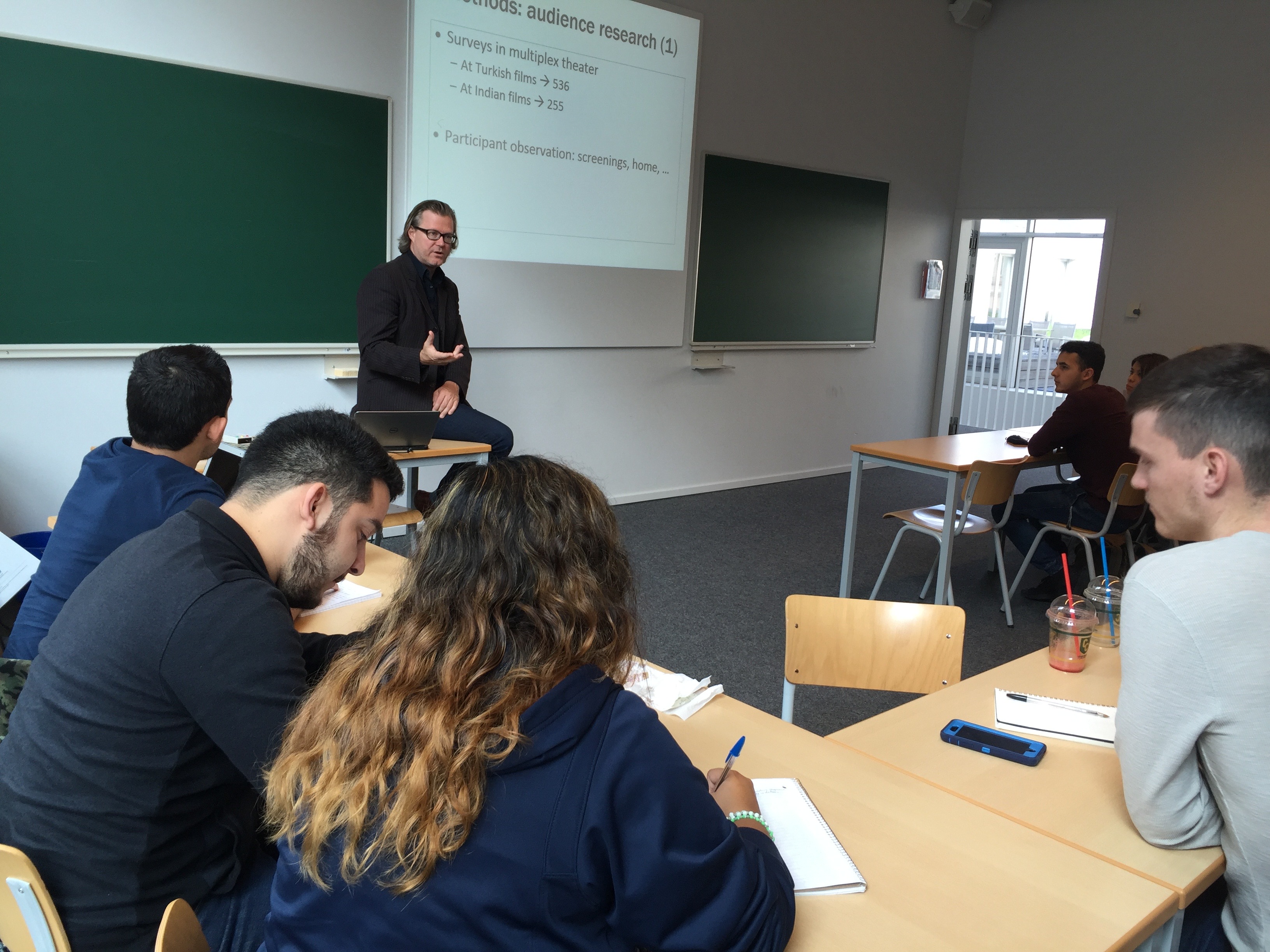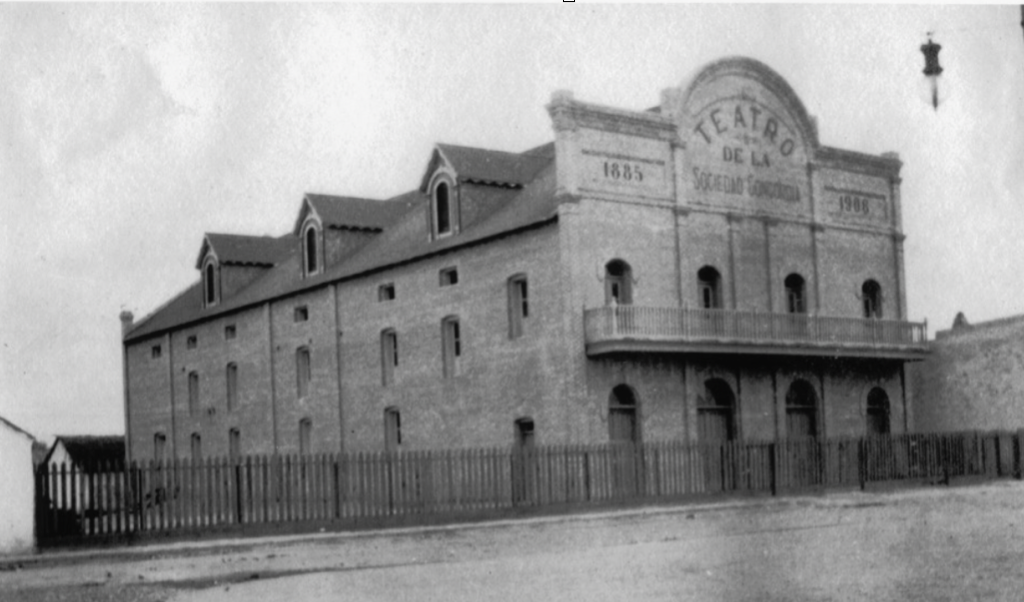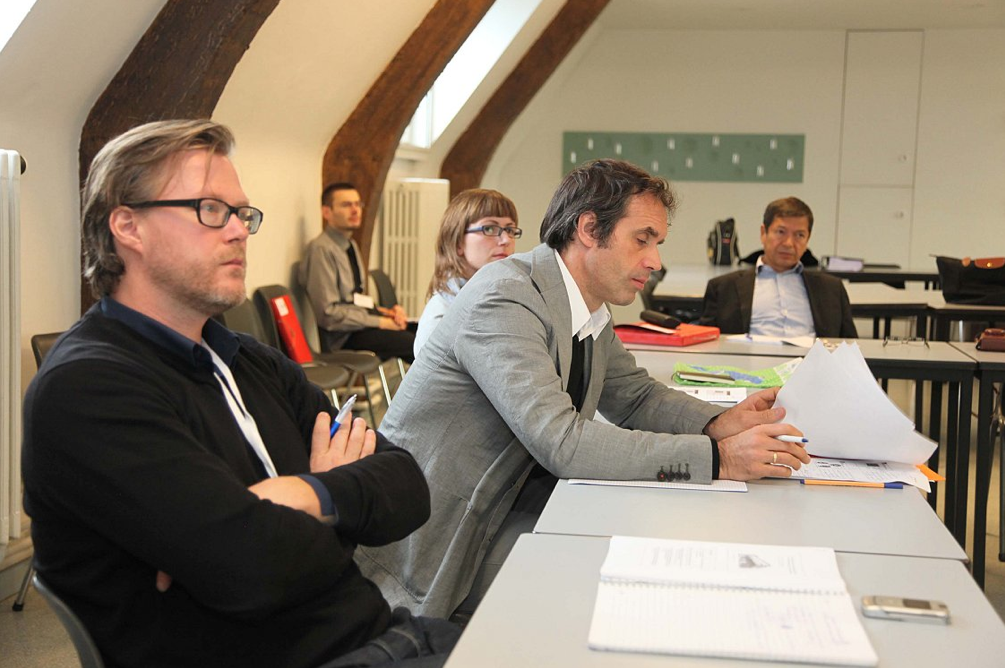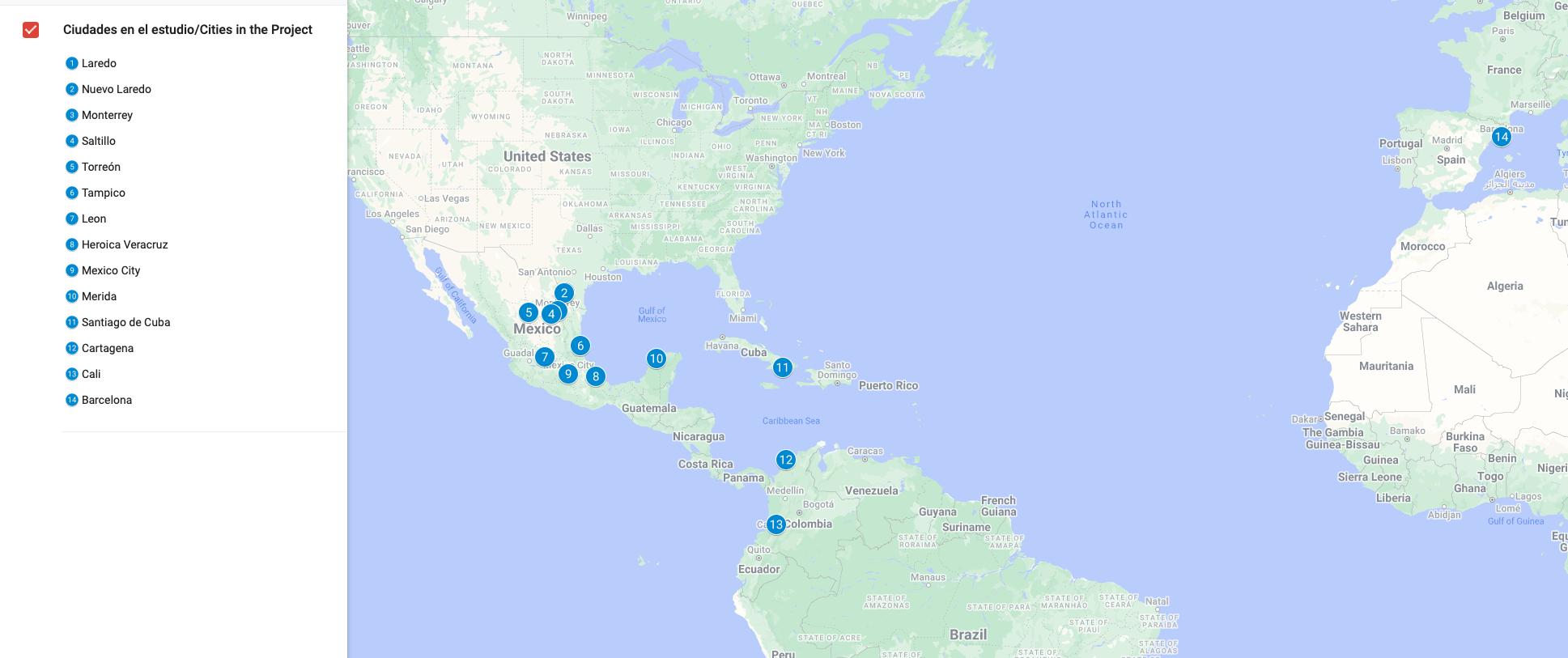The Network
- The network connects directly with wider dynamics in the field of cinema history, under the header of ‘new cinema history.’
- The network developed out of a research project The Enlightened City on the history of Belgian cinema culture and more specifically the interaction between exhibition, programming, and audience experiences.
- This project built the research design that was later replicated by the teams within the network, under the coordination of the three initiators, Daniel Biltereyst, José Carlos Lozano, and Philippe Meers.
- Each team provided its own means for research, often working with bachelor's and master’s students, involving them in an original research project and allowing them to discover parts of their own city’s cinema history.
- The network also plays a prominent role in Cinema City Cultures, as one of the key aims of the Cinema City Cultures network is precisely to foster more work on the history of urban cinematic cultures.

The Conceptual Framework: New Cinema History
- Over the past fifteen years, film and cinema studies developed from a largely text and film centered approach into a more cultural- and socio-historical approach to cinema.
- In its assessment of the wider historical conditions of the cinematic experience, this new cinema history involves the usage of several disciplinary approaches, coming from history, cultural geography, demography, ethnography, etc.
- The approach brought forward clear-cut empirical methodologies from the social sciences to a field hitherto dominated by theoretical, humanities- or text-oriented approaches. This new trans-disciplinary and multi-methodological approach equally embraces an openness towards digitization at various levels, including data collection, processing, and analysis (e.g. construction of large-scale databases on historical film exhibition sites, programming, distribution, censorship data; use of computational tools for analysis and presentation like GIS), as well as in terms of data valorization, e.g. building open-access platforms for other researchers and the wider audience.
Comparative Perspectives
- Comparison is helpful in trying to understand larger trends, factors, or conditions explaining differences and similarities in historical cinema cultures. Especially for Latin America, where empirical studies on cinema culture are rather scarce, the need for large scale comparative work is urgent.
- The Belgian project, as one of the pioneering large scale empirical projects of this kind, is very well placed for providing the comparative material, also for the Southern European findings of the Barcelona case study.
- As our projects all work with an identical methodological set-up and toolkit, resulting in identical and fully compatible databases, the comparisons should be facilitated. But even here we are confronted with problems such as interrogating some of the seemingly obvious temporal and spatial dimensions (Biltereyst & Meers, 2016)

The Model
- The aim of the CdP projects is to develop a series of multi-method longitudinal studies on cinema culture in cities of the Spanish language world.
- The ultimate goal of the network is the comparison of these individual replica projects with each other and with the findings of the original project in Belgium.
- This entails a diachronic analysis of:
- Cinema locations and institutional structures
- ‘Mapping cinemas: geographical location and institutional structures’ an institutional analysis is executed of cinemas and sites of film distribution in an urban context. The hypothesis here is that cinemas have occupied central spaces in the urban fabric of provincial and metropolitan cities, developing a symbolic, cultural, economic, and social hierarchy ranging from high-end picture palaces to low esteemed neighborhood cinemas.
- This part results in a database containing an extended historical inventory of the film exhibition structure, including the socio-geographical distribution of cinema houses, their characteristics, and types of movies shown.
- Cinema programming
- ‘Film programming trends’ starts from the hypothesis that film programming in Latin America and Europe was historically for a large part dominated by American film, except for specific areas (art house cinemas) and or specific periods (e.g. the Golden Age of Mexican cinema).
- This second part results in a large database containing a detailed description of the movies exhibited during the sample years (type of movies shown, their number of screenings, country of origin, etc.) through the analysis of programming schedules of local movie houses included in local daily newspapers.
- Ethnographic oral history audience research on cinema-going
- ‘Audience and film experiences’ shifts the attention from structures, location, and programming to consumption and experience of film culture, whereby the central hypothesis is that cinema-going is a social event, highly conditioned by contextual factors. This allows for the construction of a typology of viewers. Different types are interviewed in a qualitative set-up and in-depth interviews are executed with a substantial number of respondents (according to age, gender, etc).
- The database for part 3 contains the transcribed and coded interviews. The final phase of the project then consists of combining the three levels of analysis to achieve a nuanced, complex multi-layered view on the landscape of cinema culture for each city and later, over the different cities, regions, countries.
- Cinema locations and institutional structures

Case Studies
- Looking at these case studies we find a fascinating mix on all three central dimensions – exhibition, programming, and audiences- of particularities due to the geographical, cultural, socio-economic situation of the city studied, while other findings clearly transcend the specific context of each case and align to more international patterns, such as the importance of the movies and cinema-going in everyday life, the social experience of cinema-going, etc. We illustrate briefly with the peculiar case of Laredo, Texas (USA).
- In Laredo, a border town with a predominantly Spanish-speaking or bilingual Mexican- American population, the cultural-geographical location plays a crucial role in the historical development of cinema culture (Lozano, 2019). Laredo provides evidence of the flexibility of cinema exhibition and programming in a cultural, linguistic, and geographic context significantly different from the majority of the American market.
- Using a triangulation of methods involving a mapping of cinemas, an extensive database of films exhibited, and oral histories on cinema going, Lozano reconstructs the strategies of the Robb and Rowley company, a regional chain that controlled exhibition in the Laredo Latino market over a period of more than fifty years. The large exhibition circuit adapted its programming strategies to a particular local market: Lozano reveals the striking absence of any policy segregating Mexicans or Mexican-Americans in the chain’s cinemas, despite this being common practice in many Texan and U.S. cities in the first half of the twentieth century.
- On the level of cinema memory, this exceptional case offers equally fascinating findings. Exploring the memories of Laredo filmgoers bet-ween the ages of 64 and 95 on US and Mexican films we get a nuanced picture of the role of film stars and local venues in cinema-going, against the historical background of a fluid and complex border.

“Screen Culture” in Latin America and Spain Network
| BELGIUM/BÉLGICA | City/Ciudad, Región | |
|---|---|---|
| Daniel Biltereyst, Ghent University, BÉLGICA | Flanders, Belgium | Daniel.Biltereyst@UGent.be |
| Philippe Meers, University of Antwerp, BÉLGICA | Flanders, Belgium | philippe.meers@uantwerpen.be |
| MÉXICO | ||
| LAREDO, TEXAS / NUEVO LAREDO, TAMAULIPAS / MONTERREY, NUEVO LEÓN | ||
| José Carlos Lozano, Texas A&M International University / Universidad Autónoma de Nuevo León, MÉXICO | Laredo, Texas / Nuevo Laredo, México / Monterrey, México | jclozano16@gmail.com |
| TORREÓN, COAHUILA | ||
| Blanca Chong, Universidad Autónoma de Coahuila-Torreón, MÉXICO | Torreón, Coahuila, México | blancachong@hotmail.com |
| LEÓN, GUANAJUATO | ||
| Efraín Delgado, Universidad de La Salle Bajío, León, MÉXICO | León, Guanajuato | efraindelgado@yahoo.com.mx |
| Jaime Miguel González, Universidad de La Salle Bajío, León, MÉXICO | León, Guanajuato | cinemacityleon@gmail.com |
| TAMPICO, TAMAULIPAS | ||
| Jorge Nieto Malpica, Universidad Autónoma de Tamaulipas, MÉXICO | Tampico y Veracruz, México | jnieto@uat.edu.mx |
| Josué Ivan Picazo Baños | Tampico | josuepicazo@gmail.com |
| Lidia Rangel | Tampico | lidia88_6@hotmail.com |
| Ma. Eugenia Rosas | Tampico | genirosas@hotmail.com |
| SALTILLO, COAHUILA | ||
| Brenda Muñoz, Universidad Autónoma de Coahuila-Saltillo, MÉXICO | Saltillo, Coahuila, México | bamy27@gmail.com |
| Antonio Corona, Universidad Autónoma de Coahuila-Saltillo, MÉXICO | Saltillo, Coahuila, México | antoniorir@gmail.com |
| Miguel Sánchez, Universidad Autónoma de Coahuila-Saltillo, MÉXICO | Saltillo, Coahuila, México | miguelsanchezmaldonado@hotmail.com |
| MEXICO CITY/CIUDAD DE MÉXICO | ||
| Jerónimo Repoll, Universidad Autónoma Metropolitana, MÉXICO | Ciudad de México | jeronimorepoll@gmail.com |
| Maricela Portillo, Universidad Iberoamericana-Santa Fe, MÉXICO | Ciudad de México | marportisan@yahoo.com.mx |
| MÉRIDA, YUCATÁN | ||
| María de la Cruz Castro Ricalde | Mérida, México | maricruz.castro@tec.mx |
| CUBA | ||
| Maribel Brull González, Universidad de Oriente, CUBA | Santiago, CUBA | brull@uo.edu.cu |
| Daylenis Blanco Lobaina, Universidad de Oriente, CUBA | Santiago, CUBA | blancolobaina@gmail.com |
| COLOMBIA | ||
| CALI | ||
| Maria Luna, TecnoCampus ESUPT UPF, Barcelona | Cali, Colombia | mlunar@tecnocampus.cat |
| Ramiro Arbeláez, Escuela de Comunicación Social, Universidad del Valle (Cali), COLOMBIA | Cali, Colombia | ramiro.arbelaez@correounivalle.edu.co |
| CARTAGENA DE INDIAS | ||
| Waydi Miranda, Fundación Universitaria Colombo Internacional, Cartagena, COLOMBIA | Cartagena, Colombia | mirandaperezwa@gmail.com |
| Osiris Chajin, Fundación Universitaria Colombo Internacional, Cartagena, COLOMBIA | Cartagena, Colombia | ochajin@gmail.com |
| SPAIN / ESPAÑA | ||
| Virginia Luzón, Universidad Autónoma de Barcelona, ESPAÑA | Barcelona | virginia.luzon@uab.cat |
| Quim Puig, Universidad Autónoma de Barcelona, ESPAÑA | Barcelona | quimpuig@telefonica.net |
| Iliana Ferrer, Universidad Autónoma de Barcelona, ESPAÑA | Barcelona | iliferrer@hotmail.com |
Future Histories
- In the long term, the aim is to join all databases of each case study together in one central sustainable data depository and subsequently open them up to both the academic community and the wider public via a digital platform. Inspiration for this endeavor can be found in CINECOS, a research infrastructure project developing a ‘cinema ecosystem’ that consists of an open-access platform for sharing, enriching, analyzing, and sustaining databases on film history in Belgium. In a later phase and with the necessary funds, this platform might become a model to accommodate the CdP data-bases.
- Expanding the network to other South- American countries is another ambition for the near future. New teams from Spanish speaking countries are most welcome to join in. And as the network grows, new cinema histories of cities, countries, and regions in Latin America and Europe are in the making, helping to re-construct the fascinating, complex, and highly diverse stories of historical cinema cultures in the Spanish language world.

Publications “Screen Culture” Project /
Publicaciones derivadas del Proyecto “Cultura de la Pantalla”
Lozano, J.C. (En prensa). Cultura de la Pantalla en una ciudad fronteriza durante la época del cine silente. El caso de El Teatro Concordia de Nuevo Laredo. En José Juan Olvera (Ed.). Título Pendiente. CIESAS: México.
Lozano, José Carlos, Chong, Blanca, Delgado, Efraín, González, Jaime MIguel, Nieto Malpica, Jorge y Muñoz, Brenda (2024). Exhibition of national and foreign films in six Mexican cities during the Golden Age of Mexican Cinema: The year of 1952. In Treveri Gennari, D., Van de Vijver, L., Ercole, P. (eds) The Palgrave Handbook of Comparative New Cinema Histories. Palgrave Macmillan, Cham.
Muñoz, Brenda, Hernández, Aída, y Corona, Antonio (2024). Novedad, decepción y nostalgia en la vivencia del cine en Saltillo, México durante la década de 1980. Comunicación y Sociedad, e8700, pp. 1-18. https://www.comunicacionysociedad.cucsh.udg.mx/index.php/comsoc/article/view/e8700?articlesBySimilarityPage=27
Lozano, J.C. (2023). Memorias sobre cine mexicano y de Hollywood en una ciudad fronteriza: Historia oral de la asistencia al cine en Laredo, Texas, 1930s-1960s. En Ana Rosas Mantecón y Antonio Zirión Pérez (Coords.), Claroscuros de la memoria. Culturas cinematográficas y mundos urbanos (pp. 261-290). México: UAM-Iztapalapa y Juan Pablos Editor.
Corona, Antonio and Muñoz, Brenda (2023). Film Censorship in Mexico 1925-1928. Fiar: Forum for Inter-American Research, 16(2). https://interamerica.de/wp-content/uploads/2024/02/corona-and-munoz.pdf
Lozano, J.C., Meers, Philippe, Biltereyst, Daniel (2023). Concentración de la propiedad y el control de salas de cine en el noreste de México, el caso del Circuito Rodríguez: 1904-1947. En Clara Kriger y Nicolas Poppe (Eds.), Salas, negocios y públicos en Latinoamérica (1896-1960). Buenos Aires, Argentina: Prometeo 3010. ISBN 978-987-8267-25-8.
Hernández Chávez, A. and Muñoz, B. A. (2022). Memoria cinematográfica: la vivencia del cine en colectivo. En B. Muñoz, A. Corona and Gabriel Pérez Salazar (Coords), Producción y consumo de contenidos audiovisuales. Abordajes desde la comunicación social (pp. 87-110). Saltillo, Coahuila: Universidad Autónoma de Coahuila-AMIC. ISBN: 978-607-506-470-3. . Full Text/Texto completo: https://www.researchgate.net/publication/367176924_Memoria_cinematografica_la_vivencia_del_cine_en_colectivo
Nieto Malpica, J., Lozano, J.C., Rangel Blanco, L., Montes de Oca, Y. (2022). Organización y programación de la industria del cine en México: una mirada retrospectiva. Revista Venezolana de Gerencia (RVG), 27(100), 1537-1558. https://doi.org/10.52080/rvgluz.27.100.16. ISSN 1315-9984. Full text/Texto completo: https://dialnet.unirioja.es/servlet/articulo?codigo=8890769
Repoll, J. y Portillo, Maricela (2022). Aproximación a la historia del cine en la CDMX. Ponencia presentada en el 33 Encuentro Nacional AMIC. Full text/Texto completo:
Muñoz, B. A., Corona, A., & Meers, P. (2021). Principio de una cultura cinematográfica urbana en Saltillo, México (1898-1940). In Transformaciones mediáticas y comunicacionales en la era posdigital: proceedings of 31 Encuentro Nacional AMIC 2020, 26-27, November, Mexico (pp. 513-541).
Nieto Malpica, J., Biltereyst , D., & Rangel, L. (2020). Exhibición y programación cinematográfica en la ciudad y puerto de Veracruz, México 1952. Revista de Ciencias Sociales, 26(4), 64-96. Full text/Texto completo: https://biblio.ugent.be/publication/8683217
Gonzalez, J. M., Delgado, E., Ortega, J., & Meers, P. (2019). Exhibición y programación cinematográfica en León, México, desde la perspectiva de la nueva historia del cine (1940 a 1970). Global Media Journal México, 16(30), 28-44. Full Text/Texto Completo: https://rio.tamiu.edu/gmj/vol16/iss30/2/
Lozano, J. C. (2019). Exhibiting films in a predominantly Mexican-American market: The case of Laredo, Texas, a small USA-Mexico bordertown, 1896-1960. In D. Biltereyst , R. Maltby, & P. Meers (Eds.), The Routledge Companion to New Cinema History (pp. 254-268). London: Routledge.
Lozano, J. C., Meers, P., & Biltereyst , D. (2018). The social experience of going to the movies in the 1930s-1960s in a small Texas border town: Moviegoing habits and memories of films in Laredo, Texas. In D. Treveri-Gennari, D. Hipkins, & C. O´Rawe (Eds.), Rural cinema exhibition and audiences in a global context (pp. 155-170). Cham, Switzerland: Palgrave Macmillan. https://link.springer.com/chapter/10.1007/978-3-319-66344-9_9
Repoll, J., Castellanos, V., Portillo, M., & Meers, P. (2018). Recuerdos, heterotopías y heterocronías. La experiencia cinematográfica en la Ciudad de México. Global Media Journal México, 15(28), 17-37. Full Text/Texto Completo: https://rio.tamiu.edu/gmj/vol15/iss28/2/
Lozano, J. C. (2017). Film at the border: Memories of cinemagoing in Laredo, Texas. Memory Studies, 10(1), 35-48. doi:10.1177/1750698016670787. Full Text/Texto Completo: https://www.researchgate.net/publication/312102242_Film_at_the_border_Memories_of_cinemagoing_in_Laredo_Texas
Lozano, J. C., Biltereyst, D., & Meers, P. (2017). Naive and sophisticated long-term readings of foreign and national films viewed in a Mexican northern town during the 1930-60s. Studies in Spanish & Latin American Cinemas, 14(3), 277-296. doi:10.1386/slac.14.3.277_1. Full Text/Texto Completo: https://intellectdiscover.com/content/journals/10.1386/slac.14.3.277_1
Chong, B., Ornelas, J. L., Solis, J., & Flores, J. I. (2016). Las audiencias de cine en Torreón, Coahuila, México, durante las décadas 1940 - 1960. Global Media Journal México, 13(25). Full Text/Texto Completo: https://rio.tamiu.edu/gmj/vol13/iss25/7/
Lozano, J.C., Meers, P. y Biltereyst, D. (2016). La experiencia social histórica de asistencia al cine en Monterrey, Nuevo León, México durante las décadas de los 1930 a los 1960. Palabra Clave, Revista de Comunicación, 19(3), 691-720, Colombia. ISSN: 01228285, eISSN: 2027-534X. Full Text/Texto Completo: http://www.scielo.org.co/scielo.php?pid=S0122-82852016000300002&script=sci_abstract&tlng=en
Luzón, V., & Garcia Fleitas, E. (2016). Cinemagoing en Barcelona: una proyección al futuro mediante la experiencia de consumo de los espectadores jóvenes. Global Media Journal México, 13(25), 63-95. Full Text/Texto Completo: https://www.researchgate.net/publication/350033275_Cinemagoing_en_Barcelona_una_proyeccion_al_futuro_mediante_la_experiencia_de_consumo_de_los_espectadores_jovenes
Nieto Malpica, J., Tello, A., Rosas, M. E., & Biltereyst , D. (2016). El cine en Tampico y Ciudad Madero: exhibición, programación y contexto histórico-social en 1942. Global Media Journal México, 13(25), 159-170. Full Text/Texto Completo: https://gmjmexico.uanl.mx/index.php/GMJ_EI/article/view/266
Chong, B., Lozano, J. C., & Meers, P. (2014). El cine en Torreón, Coahuila en sus orígenes y durante los procesos de urbanización y modernización de la ciudad. Anuario de Investigación de la Comunicación CONEICC, 21, 59-87. Full Text/Texto Completo: https://www.researchgate.net/profile/Carlos-Adolfo-Gutierrez-Vidal/publication/266477117_XXI_Anuario_de_Investigacion_de_la_Comunicacion/links/543359e80cf225bddcc9a591/XXI-Anuario-de-Investigacion-de-la-Comunicacion.pdf#page=59
Luzón, V., Ferrer, I., Meers, P., Lozano, J. C., & Biltereyst, D. (2014). La memoria histórica del cine en Barcelona: una mirada al pasado a través de la experiencia de consumo de los espectadores. In F. Ubierna Gomez & J. Sierra Sanchez (Eds.), Miscelánea sobre el entorno audiovisual en 2014 (pp. 641-660). Madrid: Editorial Fragua.
Meers, P., Luzon, V., Lozano, J. C., & Biltereyst, D., Cabeza, E. (2014). Metodologías de investigación para la “nueva historia del cine”. In F. Ubierna Gomez & J. Sierra Sanchez (Eds.), Miscelánea sobre el entorno audiovisual en 2014 (pp. 695-710). Madrid: Editorial Fragua.
Portillo, M., Repoll, J., Meers, P. (2014). “Qué hubiera sido de mi vida sin el cine?” La experiencia cinematográfica en la Ciudad de México. Contratexto, (22), 213-228. Full Text/Texto Completo: https://www.redalyc.org/pdf/5706/570667380011.pdf
Frankenberg, L., & Lozano, J. C. (2013). Memories of films and cinema going in Monterrey, Mexico: A critique and review of in-depth interviews as a methodological strategy in audience studies. In A. Valdivia & F. Darling-Wolf (Eds.), The International Encyclopedia pf Media Studies: Research Methods in Media Studies (Vol. 7, pp. 179-198). Malden, MA: Wiley-Blackwell.
Lozano, J. C., Biltereyst , D., Frankenberg, L., Meers, P., & Hinojosa, L. (2012). Exhibición y programación cinematográfica de 1922 a 1962 en Monterrey, México: un estudio de caso desde la perspectiva de la “Nueva historia del cine”. Global Media Journal Mexico, 9(18), 73-94. Full Text/Texto Completo: https://rio.tamiu.edu/gmj/vol9/iss18/5/
Tesis derivadas del proyecto
Ocampo, C. R. I. (2019). El cine como creador de modelos de vida para el tampiqueño. Seis relatos sobre Cultura de la Pantalla. [Tesis de Licenciatura]. Universidad Autónoma de Tamaulipas.
